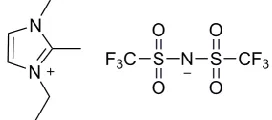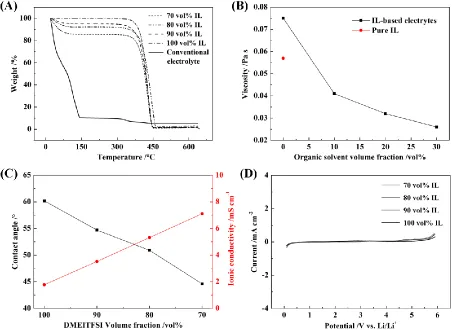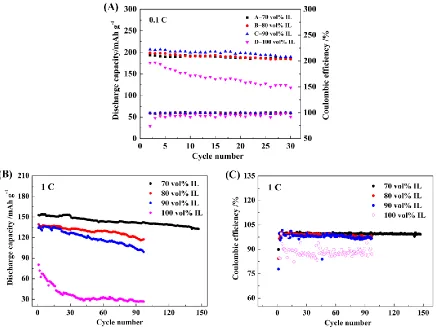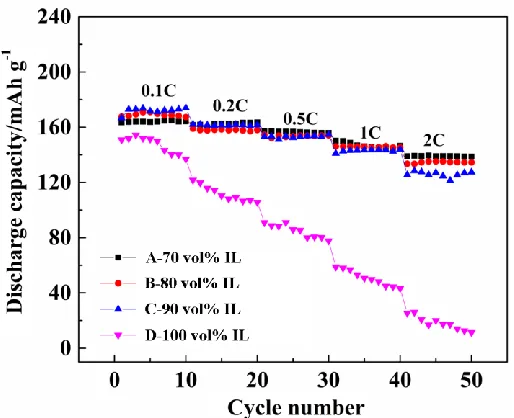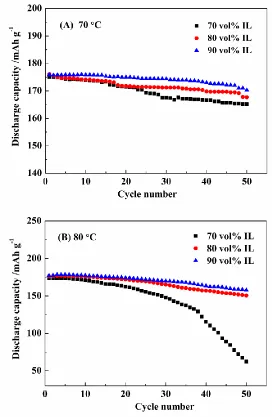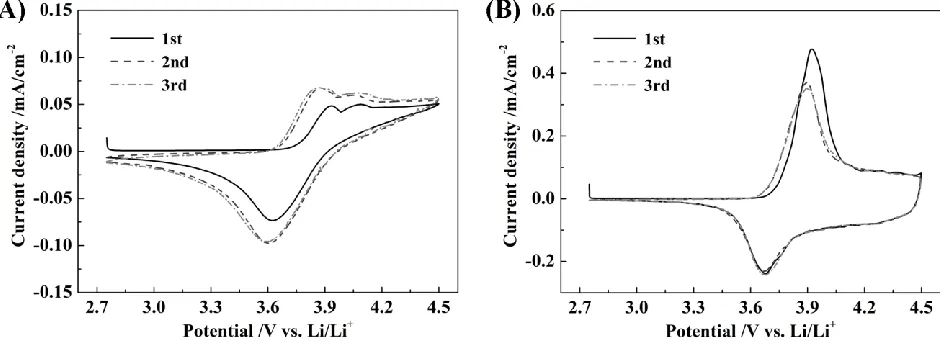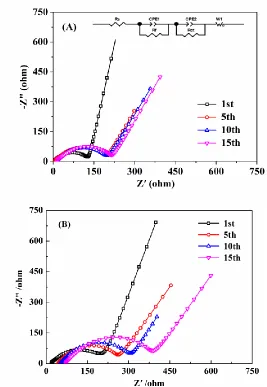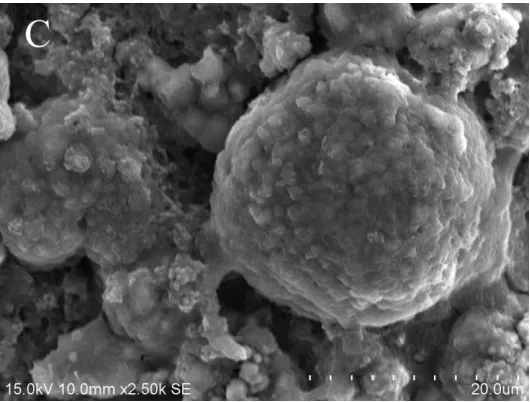Int. J. Electrochem. Sci., 11 (2016) 6149 – 6163, doi: 10.20964/2016.07.53
International Journal of
ELECTROCHEMICAL
SCIENCE
www.electrochemsci.org
Enhanced Performance of LiNi
1/3Co
1/3Mn
1/3O
2Cathodes at
Elevated Temperatures Using an Imidazolium-Based Electrolyte
with Lithium Difluoro(oxalate)Borate
Zhenfeng Wang, Jianhong Liu, Cuihua Li, Peixin Zhang, Haitao Zhuo
College of Chemistry and Environmental Engineering, Shenzhen University, No.3688, Nanhai District, Shenzhen 518060, China
*
E-mail: licuihuasz@163.com, pxzhang2000@163.com
Received: 8 April 2016 / Accepted: 16 May 2016 / Published: 4 June 2016
Novel electrolytes containing 1,2-dimethyl-3-ethylimidazolium bis(trifluoromethylsulfonyl)imide, an ionic liquid (DMEITFSI); carbonate solvents; and lithium difluoro(oxalate)borate (LiDFOB) were prepared, and the electrochemical performance in Li/LiNi1/3Co1/3Mn1/3O2 half cells was investigated.
The ionic liquid electrolytes exhibited excellent physical and electrochemical properties, including high thermal stability, incombustibility and a wide electrochemical window. The addition of LiDFOB significantly improved the compatibility of the ionic liquid with Li/LiNi1/3Co1/3Mn1/3O2, which
presented a discharge capacity of 138.5 mAh g-1 after 100 cycles at 1.0 C. Among the tested electrolytes, Li/LiNi1/3Co1/3Mn1/3O2 cells showed the best performance at high temperatures, delivering
superior discharge capacities of 157.7 mAh g-1 after 50 cycles at a rate of 1.0 C and a temperature of 80 °C. The decomposition of LiDFOB resulted in the formation of a stable and protective film on the surface of the LiNi1/3Co1/3Mn1/3O2 cathode. Therefore, nonflammable DMEITFSI-based electrolytes
are an excellent alternative for lithium-ion batteries at room and elevated temperatures.
Keywords: Hybrid electrolyte, Ionic liquid, Safe electrolyte, High temperature, Lithium difluoro(oxalate)borate.
1. INTRODUCTION
Lithium-ion batteries (LIBs) have been widely used in various electronic devices; however, their energy and power density do not meet the demand of future electric vehicles and hybrid electric vehicles [1-3]. Recently, LiNi1/3Co1/3Mn1/3O2 has been shown to be an attractive cathode material for
a safe electrolyte with a wide electrochemical window and good electrode compatibility must be designed for LIBs.
Ionic liquids (ILs) have been investigated as safe electrolytes due to their wide liquid state range and electrochemical stability window, negligible volatility, non-flammability, etc. [10-13]. The most widely studied ILs for various applications are 1,3-dialkylimidazolium ILs, especially 1-ethyl-3-methylimidazolium ILs, due to its ease of preparation and low viscosity [14-17]. However, the presence of an active hydrogen at the C-2 position of the 1,3-dialkylimidazolium ring leads to electrochemical instability, which limits its usage in lithium batteries [18-20]. 1,2,3-Trialkylimidazolium ILs are produced after substituting the hydrogen at the C-2 position of the 1,3-dialkylimidazolium ring with an alkyl group. The resulting electrochemical stabilities are improved; thus, these ILs are attractive electrolytes for lithium batteries, even though their viscosities increase slightly with an increase in cation size [21].
Despite the outstanding stability of these ionic liquids, they also suffer from several disadvantages, such as high viscosity and poor compatibility with the cathode or anode due to the co-intercalation and decomposition of imidazolium cations on the surface of the electrode. The use of carbonate solvents and electrolyte additives are the most effective methods for solving the aforementioned disadvantages of ILs. For example, organic carbonates have been added to decrease the viscosity of neat ionic liquids and increase the electrode stability [22-24].
Lithium difluoro(oxalate)borate (LiDFOB) is an effective functional additive for improving cell performance [25-27]. Hu et al. [28] reported that the addition of LiDFOB improved the cyclic stability of LiCoPO4 by forming a stable surface film, which passivated the cathode surface and
inhibited electrolyte decomposition [29-31]. Independently, similar results were obtained by Chen et al. [32], confirming the ability of LiDFOB in carbonate-based electrolytes to support the cycling stability of LiNi1/3Co1/3Mn1/3O2 electrodes.
The effects of 1,2,3-trialkylimidazolium ionic liquid-based electrolytes on the electrode performance have only been marginally described in the literature. To date, studies on the addition of LiDFOB into 1,2-dimethyl-3-ethylimidazolium bis(trifluoromethylsulfonyl)imide (DMEITFSI)-based electrolytes and the effects on the electrochemical performance of LiNi1/3Co1/3Mn1/3O2 cathodes have
seldom been reported. Therefore, the aim of the present study was to identify optimal DMEITFSI-based electrolytes for high capacity LiDFOB cathodes at room and elevated temperature and to better understand the effects of IL and LiDFOB on LiNi1/3Co1/3Mn1/3O2 cathodes. The physical and
electrochemical properties of ionic liquid electrolytes containing DMEITFSI, lithium bis(trifluoromethanesulfonyl)imide (LiTFSI) and LiDFOB were evaluated. Particularly, the cyclic performance of DMEITFSI-based electrolytes in Li/LiNi1/3Co1/3Mn1/3O2 half cells at temperatures of
70 and 80 °C was explored.
2. EXPERIMENTAL
2.1 Synthesis of DMEITFSI
[image:3.596.229.365.192.252.2]
Aesar, >98%) were dissolved in ethyl acetate (25 mL) and stirred overnight at 25 °C. After purification by washing with ethyl acetate, the intermediate 1,2-dimethyl-3-ethylimidazolium bromide (DMEIBr) was obtained as a white solid in 91% yield (18.6 g). Subsequently, 18.6 g of DMEIBr, which was produced in the first step, was dissolved in 10 mL of deionized water, and the resulting mixture was added into a solution of 28.7 g of LiTFSI (Acros, >98%) in 10 mL of deionized water. The mixture was stirred at 25 °C for 24 h.
Figure 1. The chemical structure of DMEITFSI
The product of this reaction, DMEITFSI, was removed and washed several times with deionized water until bromide was not detected by titration with 0.1 mol L-1 AgNO3. The remaining
water was removed under vacuum at 110°C for 48 hours. The final product was a clear colorless liquid (yield: 35.3 g, 87.0%). The water content was less than 50 ppm and was measured via Karl Fischer analysis. The purity of the IL was determined using 1H nuclear magnetic resonance (1H NMR) on a 400 MHz spectrometer (VNMRS 400, Varian). The chemical shifts are reported in ppm downfield from tetramethylsilane. DMEITFSI δH (400 MHz, DMSO-d6): 7.65 (d, J=1.8 Hz, 1H), 7.64–7.57 (m,
1H), 4.13 (dd, J=14.2, 7.0 Hz, 2H), 3.75 (d, J=5.7 Hz, 3H), 2.58 (d, J=5.7 Hz, 3H), 1.34 (t, J=7.2 Hz, 3H).
2.2 Preparation of DMEITFSI-based electrolytes and half cells
LiDFOB (Beijing Isomersyn Technology Co., Ltd., China), dimethyl carbonate (DMC, Shenzhen Tianjiao Sources Technology Co., Ltd., China) and vinylene carbonate (VC, Acros, >98%) were used as received. DMEITFSI-based electrolytes with a composition and systematic nomenclature of 0.3 M LiTFSI/ vol% DMEITFSI+(95-) vol% DMC+5 vol% VC+0.25 wt% LiDFOB were prepared with values ranging from 70 to 90. These DMEITFSI-based electrolytes were indicated by 70, 80 and 90 vol% IL. The other DMEITFSI-based electrolyte consisted of 0.3 M LiTFSI/ DMEITFSI+5 vol% VC+0.25 wt% LiDFOB was also prepared and named as 100 vol% IL. A conventional electrolyte, which consisted of 1 M LiPF6-EC/DMC/EMC (1/1/1, v/v/v), was used for
comparison. The HF and water content of the electrolytes were less than 50 ppm, which determined by Karl-Fisher titration. The electrode with an active loading of about 2.3 mg cm-2 was prepared using a mixture of 80 wt% LiNi1/3Co1/3Mn1/3O2, 10 wt% carbon black, and 10 wt%
atmosphere (O2<0.1 ppm, H2O<0.1 ppm; UNILab, Mbraun). Same amount of electrolyte of 55 L was
used for each coin cell.
2.3 Physical-chemical characterization and evaluation of the cells
The flammability of the electrolytes was evaluated according to the method described in our previous study [33]. Briefly, 200 L of electrolyte was added into an stainless steel container and was carefully ignited. The electrolyte was judged to be non-flammable if the electrolyte did not ignite during testing. The thermogravimetric analysis (TGA) of DMEITFSI-based electrolytes was carried out using a thermal analysis system (Q50, TA instruments) under a nitrogen atmosphere at room temperature to 640 °C and a heating rate of 5 °C min−1.The viscosity of DMEITFSI-based electrolytes was measured at 25±1 °C using a rotational viscometer (AR1000, TA instruments) with a cone-plate configuration in control shear rate mode. The contact angle between DMEITFSI-based electrolytes and the separator was measured using a contact angle meter (JC2000C1, POWEREACH).
The ionic conductivity of DMEITFSI-based electrolytes was measured by AC impedance spectroscopy on an electrochemical workstation (1470E Cell Test System, Solartron) using a two Pt-electrode cell. Electrochemical measurements, including electrochemical impedance spectroscopy (EIS), linear sweep voltammetry (LSV) and cyclic voltammetry (CV) were measured in coin-type cells on the aforementioned electrochemical workstation (1470E Cell Test System, Solartron). The EIS of Li/LiNi1/3Co1/3Mn1/3O2 cells at various cycles was tested in a frequency range of 105 Hz to 10-2 Hz with
an amplitude of 10 mV. The CV of Li/LiNi1/3Co1/3Mn1/3O2 cells was measured at 2.75-4.5 V and a
scan rate of 0.1 mV s-1. The electrochemical stability of the electrolytes was tested via LSVin Li/Pt cells at 0 to 6 V and a scan rate of 0.1 mV s1. The cycling performance of Li/LiNi1/3Co1/3Mn1/3O2 cells
containing the studied electrolytes was determined using a Land CT2001A battery testing system at different rates and voltages of 2.75-4.5 V. A scanning electron microscope (SEM, S3400N, Hitachi) coupled with an energy dispersive spectrometer (EDS) was used to investigate the surface morphology and composition of pristine and cycled electrodes.
3. RESULTS AND DISCUSSION
3.1 Physical and electrochemical properties
The flammability and thermal stability of electrolytes are the primary factors affecting battery safety. We observed that the as-prepared electrolytes were non-flammable and could meet the safety demands when the IL content was set to 70 vol% (This result is not shown here).
carbonate-based electrolyte was heated from 20 to 100 °C. For electrolytes with 70, 80, and 90 vol% IL, the weight losses were 14.0, 7.7 and 4.7 wt%, respectively. The volatility of the carbonate solvent decreased due to the addition of the ionic liquid, which was attributed to the strong intermolecular forces between the IL and organic solvent [34].
Figure 2. Physical and electrochemical properties of IL-based electrolytes: (A) thermogravimetric analysis, (B) viscosity, (C) contact angle and conductivity and (D) linear sweep voltammograms
The viscosity of the mixed electrolytes and pure IL is presented in Fig. 2B. DMEITFSI displayed a relatively high viscosity, and the addition of lithium salts to the IL increased the viscosity. One method of decreasing the viscosity of a liquid is to add an organic solvent such as DMC. The addition of 10 vol% DMC to the electrolyte significantly decreased the viscosity by 45%. As the amount of DMC in the electrolyte increased, the viscosity of the electrolyte decreased gradually because interaction forces among molecules in the electrolyte also decreased upon DMC addition [35].
[image:5.596.71.525.178.508.2]
the mixture was positively correlated with the viscosity. The electrolyte containing 70, 80, 90 and 100 vol% of DMEITFSI displayed conductivities of 7.11, 5.32, 3.52 and 1.78 mS cm-1, respectively. Notably, the conductivity of the mixtures was inversely correlated to the viscosity.
The electrochemical stability of neat DMEITFSI and DMEITFSI-based electrolytes was measured by LSV. As shown in Fig. 2D, oxidation and reduction peaks were not observed in the range of 0 to 5.5 V for all of the tested cells, indicating that the electrochemical stability of DMEITFSI-based electrolytes was high, even when the concentration of organic solvents was set to contents as high as 30 vol%. This result confirmed the feasibility of DMEITFSI-based electrolytes for lithium-ion batteries.
[image:6.596.168.432.282.679.2]3.2 Cyclic performance of Li/LiNi1/3Co1/3Mn1/3O2 cells at room temperature
Figure 3. Cyclic performance (A) and columbic efficiency (B) of Li/LiNi1/3Mn1/3Co1/3O2 at a voltage
Fig. 3 shows the cyclic performance of Li/LiNi1/3Co1/3Mn1/3O2 cells in different electrolytes at
a temperature of 25 °C, a rate of 0.1 C and a voltage range of 2.75-4.5 V. Electrolyte (b), which contained LiDFOB and DMC, exhibited excellent performance, similar to the conventional carbonate electrolyte (a). Compared to electrolyte (b), the discharge capacity decreased dramatically in the absence of LiDFOB, and a low capacity of 110.4 mAh g-1 was obtained after 30 cycles due to the decomposition of DMEI+ on the surface of the electrode [22]. The addition of LiDFOB to the electrolyte (c) prevented the above-mentioned process and resulted in the formation of a stable SEI film on the surface of the LiNi1/3Co1/3Mn1/3O2 electrode. With respect to safety, the optimal electrolyte
composition included DMEITFSI, DMC and LiDFOB (0.3 M LiTFSI/ vol% DMEITFSI + (95-) vol% DMC + 5 vol% VC+0.25 wt% LiDFOB). Thus, this type of electrolyte was used in the following tests.
Figure 4. Cyclic performance of LiNi1/3Mn1/3Co1/3O2 in IL-based electrolytes containing LiDFOB at
25 °C and 0.1 C and 1.0 C
As shown in Fig. 4A, the initial discharge capacity of Li/LiNi1/3Co1/3Mn1/3O2 cells reached
and columbic efficiencies due to the high viscosity of the electrolyte, which reduced the migration rate of Li+. The observed side effects of high viscosity are evident in Fig. 4B, which shows the performance characteristics obtained at a rate of 1.0 C, voltages ranging from 2.75-4.5 V and a temperature of 25 °C. Throughout the entire 150-cycle experiment, the electrolyte containing 70 vol% IL showed superior performance compared to the electrolyte with 80 and 90 vol% DMEITFSI. As the amount of DMEITFSI in the electrolyte increased, the discharge capacities of the cell decreased gradually at room temperature.
Figure 5. Rate performance of Li/LiNi1/3Mn1/3Co1/3O2 cells using IL-based electrolytes containing
LiDFOB at 25 °C
The rate capability is an important factor affecting the cyclic performance. The rate performance of Li/LiNi1/3Co1/3Mn1/3O2 cells with DMEITFSI-based electrolytes is shown in Fig. 5.
The rate capabilities of the cells decreased according in the following order: Cell A (70 vol% IL) > Cell B (80 vol% IL) > Cell C (90 vol% IL) > Cell D (100 vol% IL). The discharge capacity of the cell containing 100 vol% IL electrolyte (Cell D) rapidly decreased to 25.4 mAh g-1 at 2.0 C, which was only 16.8% of the discharge capacity at 0.1 C. Cell A (70 vol% IL), Cell B (80 vol% IL) and Cell C (90 vol% IL) exhibited comparable discharge capacities of 139.0, 133.6 and 125.5 mAh g-1, respectively, up to a rate of 2.0 C. The rate performance of the cathode in 70-90 vol% DMEITFSI-based electrolyte was sufficient for many applications.
3.3 Cyclic performance of Li/LiNi1/3Co1/3Mn1/3O2 cells at elevated temperature
Fig. 6 shows the cyclic performance of LiNi1/3Co1/3Mn1/3O2 in electrolytes with different
[image:8.596.168.425.206.415.2]
vol% IL) at 70 °C and 9.9% (70 vol% IL), 26.6% (80 vol% IL), 28.8% (90 vol% IL) at 80 °C, respectively. In addition, improved capacity retention was achieved in cells cycled in larger amounts of IL at higher temperatures.
Figure 6. Cyclic performance of Li/LiNi1/3Mn1/3Co1/3O2 cells in IL-based electrolytes containing
LiDFOB at 1.0 C and (A) 70 °C and (B) 80 °C
[image:9.596.163.435.144.561.2]
capacity. DMEITFSI-based electrolytes with higher IL contents provided better compatibility with LiNi1/3Co1/3Mn1/3O2 at high temperature and may be a promising choice for lithium-ion batteries at
high temperature.
3.4 Electrochemical behavior of LiNi1/3Co1/3Mn1/3O2 cathodes
The CV curves of LiNi1/3Co1/3Mn1/3O2 cells containing electrolyte with and without LiDFOB
are provided in Fig. 7.
Figure 7. Cyclic voltammograms of Li/LiNi1/3Mn1/3Co1/3O2 cells containing (A) standard electrolyte
and (B) electrolyte with LiDFOB at 0.1 mV s-1
As shown in Fig. 7A, a broad anodic peak was observed at 3.9-4.5 V in the first circle, which was attributed to the oxidation reaction between the electrolyte and the electrode. After the second scan, the electrochemical behavior of the LiNi1/3Co1/3Mn1/3O2 electrode was poor. The electrochemical
profiles of LiNi1/3Co1/3Mn1/3O2 electrodes containing LiDFOB (Fig. 7B) showed a sharp oxidation
peak at 3.92 V in the first positive scan, corresponding to the oxidation of Ni2+ and Co3+to Ni4+ and Co4+, respectively. The reduction peak at 3.68 V was due to the reduction of Ni4+ and Co4+ [10]. After the first cycle, the current density of the oxidation process decreased slightly but remained stable in the next cycle,suggesting that lithium insertion and extraction from the LiNi1/3Co1/3Mn1/3O2 electrode
was highly reversible. Therefore, the addition of LiDFOB suppressed undesirable interfacial reactions between the electrolyte and electrode.
The electrochemical impedance spectra of Li/LiNi1/3Co1/3Mn1/3O2 cells were collected after the
1st, 5th, 10th and 15th cycle at 1.0 C and 25 °C (Fig. 8A and B). The EIS spectra were fitted with the equivalent circuit inserted in Fig. 8A and the values of Rs, Rf and Rct were listed in Table 1. As
previously reported, Rs represents the resistance contribution from the electrolyte and cell case, Rf is
the resistance of the film formed on the surface of the cathode, and Rct is related to the resistance of the
[image:10.596.63.533.235.406.2]
Figure 8. EIS plots of Li/LiNi1/3Mn1/3Co1/3O2 cells in IL-based electrolytes containing LiDFOB. (A)
70 vol% IL and (B) 90 vol% IL
Table 1. Impedance parameters calculated by equivalent circuits in IL-based electrolytes with LiDFOB
Sample Rs/Ω Rf/Ω Rct/Ω
70vol% IL(1st) 4.059 7.138 119
70vol% IL(5th) 4.596 14.76 173.7
70vol% IL (10th) 12.44 14.57 168.7
70vol% IL (15th) 12.87 23.88 176.1
90vol% IL (1st) 16.74 8.954 135.1
90 vol% IL (5th) 42.38 56.83 152.5
90 vol% IL (10th) 49.11 60.43 179.7
90 vol% IL (15th) 68.39 91.39 201.1
For cell cycled in the electrolyte containing 90 vol% IL, Rs, Rf and Rct remarkably increased as
[image:11.596.163.430.72.459.2] [image:11.596.109.488.564.691.2]
slightly with cycling, much smaller values of Rs than those cycled in the electrolyte containing 90
vol% IL, indicating that the 70 vol% electrolyte shows good compatibility with LiNi1/3Co1/3Mn1/3O2
cathode. Since appropriate amount of DMC decrease the viscosity of the electrolyte, Li+ is able to be more easily transfer to the electrode surface and then enter the structure of the electrode. As a result, the cell with 70 vol% IL electrolyte exhibits better cyclic performance.
3.5 Surface analysis of LiNi1/3Co1/3Mn1/3O2 cathodes
SEM images of pristine and cycled LiNi1/3Co1/3Mn1/3O2 cathodes are presented in Fig. 9. The
Figure 9. SEM images of pristine LiNi1/3Mn1/3Co1/3O2 cathodes (a) and cycled LiNi1/3Mn1/3Co1/3O2
cathodes after 30 cycles using (b) LiDFOB-free and (c) LiDFOB-based electrolytes
The addition of LiDFOB led to the formation of a stable interphase film and passivated the surface of the LiNi1/3Co1/3Mn1/3O2 cathode [28]. Therefore, DMEITFSI-based electrolytes containing
LiDFOB were compatible with LiNi1/3Co1/3Mn1/3O2. This observation is in accordance with the
galvanostatic measurements.
Energy dispersive spectroscopy is a useful tool for the compositional analysis of solid surfaces [41, 42]. The concentrations of elements observed on the electrode surface are shown in Table 2.
Compared to fresh electrodes and electrodes cycled without LiDFOB, electrodes cycled with LiDFOB possessed lower Co, Mn and Ni contents and higher B and O contents, which was indicative of the irreversible decomposition of LiDFOB on the surface of the electrode. Similar results were obtained in Li/LiCoPO4 cells cycled with carbonate-based electrolyte containing LiDFOB [28]. The
observed increase in the B content was consistent with the CV curves of LiNi1/3Co1/3Mn1/3O2 shown in
Fig. 7B. These results suggested that LiDFOB decomposed during the process and assisted in the formation of a compact and stable interphase film on the surface of the LiNi1/3Co1/3Mn1/3O2cathode,
[image:13.596.166.431.69.270.2]which passivated the cathode surface and reduced the decomposition of DMEI+ on the surface of the LiNi1/3Co1/3Mn1/3O2 cathode.
Table 2. Surface concentration of the elements in the fresh and cycled LiNi1/3Mn1/3Co1/3O2 cathodes in
the electrolytes with or without LiDFOB
Sample C O F B Mn Ni Co
Fresh cathode 15.55 32.67 7.15 0 12.47 23.05 9.10 Cycled cathode without
LiDFOB
[image:13.596.81.515.658.734.2]
4. CONCLUSIONS
Novel electrolytes based on DMEITFSI, DMC and LiDFOB were prepared for Li/LiNi1/3Co1/3Mn1/3O2 half cells and exhibited enhanced safety and good compatibility with
LiNi1/3Co1/3Mn1/3O2 cathodes at room and elevated temperatures. The optimal composition of
DMEITFSI-based electrolytes was explored based on their electrochemical performance. The electrolyte containing DMEITFSI and LiDFOB showed high conductivity (7.11 mS cm-1 at 25 °C), low viscosity (0.026 Pa s), high thermal stability (up to 320 °C) and a large overall stability window of more than 5.5 V. The cyclic performance of the electrolyte in Li/LiNi1/3Co1/3Mn1/3O2 half cells was
also encouraging, showing a discharge capacity of ca. 132.6 mAh g-1 after 150 cycles at 1.0 C and 25 °C, which was comparable to the performance of conventional carbonate-based electrolytes. Cells containing Li/LiNi1/3Co1/3Mn1/3O2, 90 vol% IL and LiDFOB delivered a discharge capacity of 177.2
mAh g-1 and a capacity retention of 89.0% at 1.0 C after 50 cycles at 80 °C. The presence of LiDFOB in the electrolyte resulted in the formation of a compact and stable SEI film, which reduced the decomposition of DMEI+ on the surface of the LiNi1/3Co1/3Mn1/3O2 cathode, leading to enhanced
electrochemical performance and stability at high temperature.
ACKNOWLEDGEMENT
This work was financially supported by National Natural Science Foundation (51574166) and Scientific and Technological Research and Development Foundation of Shenzhen City (JCYJ20140418193546111).
References
1. M. Armand and J-M. Tarascon, Nature, 451 (2008) 652-657.
2. A.S. Aricò, P. Bruce, B. Scrosati, J-M. Tarascon and W. Van Schalkwijk, Nat. Mater., 4 (2005) 366-377.
3. L. Su, Y. Jing and Z. Zhou, Nanoscale, 3 (2011) 3967-3983.
4. Q. Wu, W. Lu, M. Miranda, T.K. Honaker-Schroeder, K.Y. Lakhsassi and D. Dees, Electrochem. Commun., 24 (2012) 78-81.
5. C.S. Johnson, J.S. Kim, C. Lefief, N. Li, J.T. Vaughey and M.M. Thackeray, Electrochem. Commun., 6 (2004) 1085-1091.
6. J-H. Lim, H. Bang, K-S. Lee, K. Amine and Y-K. Sun, J. Power Sources, 189 (2009) 571-575. 7. M. Wang, Z. Shan, J. Tian, K. Yang, X. Liu, H. Liu and K. Zhu, Electrochim. Acta, 95 (2013)
301-307.
8. P.G. Balakrishnan, R. Ramesh and T. Prem Kumar, J. Power Sources, 155 (2006) 401-414. 9. J.B. Goodenough and Y. Kim, Chem. Mater., 22 (2009) 587-603.
10. H. Li, J. Pang, Y. Yin, W. Zhuang, H. Wang, C. Zhai and S. Lu, RSC Adv., 3 (2013) 13907-13914. 11. H. Nakagawa, Y. Fujino, S. Kozono, Y. Katayama, T. Nukuda, H. Sakaebe, H. Matsumoto and K.
Tatsumi, J. Power Sources, 174 (2007) 1021-1026.
12. Y. Jin, S. Fang, M. Chai, L. Yang, K. Tachibana and S. Hirano, J. Power Sources, 226 (2013) 210-218.
13. X-G. Sun, C. Liao, N. Shao, J.R. Bell, B. Guo, H. Luo, D. Jiang and S. Dai, J. Power Sources, 237 (2013) 5-12.
15. J. Ranke, S. Stolte, R. Störmann, J. Arning and B. Jastorff, Chem. Rev., 107 (2007) 2183-2206. 16. J. Dupont and J.D. Scholten, Chem. Soc. Rev., 39 (2010) 1780-1804.
17. J-K. Kim, A. Matic, J-H. Ahn and P, Jacobsson, J. Power Sources, 195 (2010) 7639-7643. 18. H. Saruwatari, T. Kuboki, T. Kishi, S. Mikoshiba and N. Takami, J. Power Sources, 195 (2010)
1495-1499.
19. I.A. Profatilova, N-S. Choi, S.W. Roh and S.S. Kim, J. Power Sources, 192 (2009) 636-643. 20. M. Egashira, H. Todo, N. Yoshimoto, M. Morita and J-I. Yamaki, J. Power Sources, 174 (2007)
560-564.
21. Y. Jin, S. Fang, M. Chai, L. Yang, K. Tachibana and S. Hirano, J. Power Sources, 226 (2013) 210-218.
22. J. Reiter, M. Nadherna and R. Dominko, J. Power Sources, 205 (2012) 402-407. 23. H. Zheng, K. Jiang, T. Abe and Z. Ogumi, Carbon, 44 (2006) 203-210.
24. X-G. Sun and S. Dai, Electrochim. Acta, 55 (2010) 4618-4626.
25. J. Liu, Z. Chen, S. Busking and K. Amine, Electrochem. Commun., 9 (2007) 475-479.
26. J. Liu, Z. Chen, S. Busking, I. Belharouak and K. Amine, J. Power Sources, 174 (2007) 852-855. 27. J. Li, K. Xie, Y. Lai, Z.A. Zhang, F. Li, X. Hao, X. Chen and Y. Liu, J. Power Sources, 195 (2010)
5344-5350.
28. M. Hu, J. Wei, L. Xing and Z. Zhou, J. Appl. Electrochem., 42 (2012) 291-296.
29. Y. Zhu, Y. Li, M. Bettge and D.P. Abraham, J. Electrochem. Soc., 159 (2012) A2109-A2117. 30. S.S. Zhang, Electrochem. Commun., 8 (2006) 1423-1428.
31. M.H. Fu, K.L. Huang, S.Q. Liu, J.S. Liu and Y.K. Li, J. Power Sources, 195 (2010) 862-866. 32. Z. Chen, J. Liu and K. Amine, Electrochem. Solid St., 10 (2007) A45-A47.
33. B. Yang, C. Li, J. Zhou, J. Liu and Q. Zhang, Electrochim. Acta, 148 (2014) 39-40.
34. S. Wilken, S. Xiong, J. Scheers, P. Jacobsson and P. Johansson, J. Power Sources, 275 (2015) 935-942.
35. R-S. Kühnel, N. Böckenfeld, S. Passerini, M. Winter and A. Balducci, Electrochim. Acta, 56 (2011) 4092-4099.
36. L. Zhang, Y. Ma, X. Cheng, P. Zuo, Y. Cui, T. Guan, C. Du, Y. Gao and G. Yin, Solid State Ionics, 263 (2014) 146-151.
37. J.Q. Zhang, Electrochemical Measurement Technology, Chemical Industry Press, Beijing (2010). 38. J.M. Zheng, Z.R. Zhang, X.B. Wu, Z.X. Dong, Z. Zhu and Y. Yang, J. Electrochem Soc., 155
(2008) A775-A782.
39. C.L. Tan, H.J. Zhou, W.S. Li, X.H. Hou, D.S. Lü, M.Q. Xu and Q.M. Huang, J. Power Sources, 184 (2008) 408-413.
40. C. Yu, G. Li, X. Guan, J. Zheng, D. Luo and L. Li, Phys. Chem. Chem. Phys., 14 (2012) 12368-12377.
41. N-S. Choi, K.H. Yew, H. Kim, S.S. Kim and W.U. Choi, J. Power Sources, 172 (2007) 404-409. 42. L. Zhao, J. Yamaki and M. Egashira, J. Power Sources, 174 (2007) 352-358.
